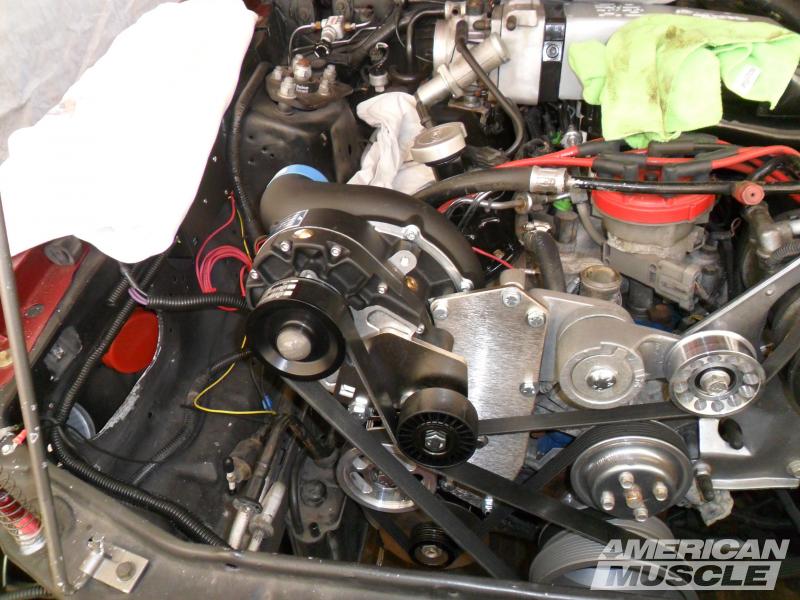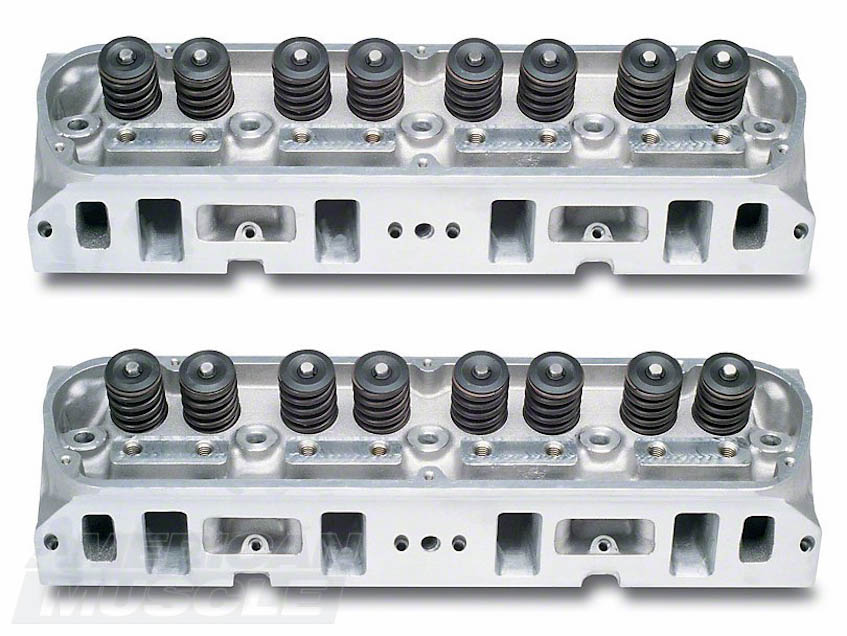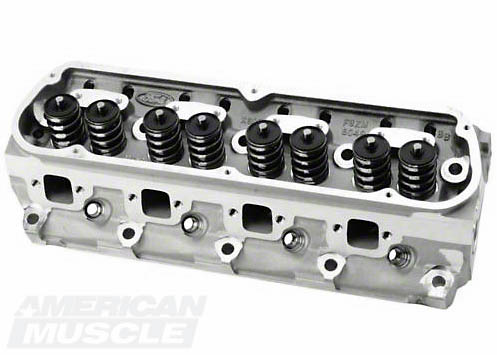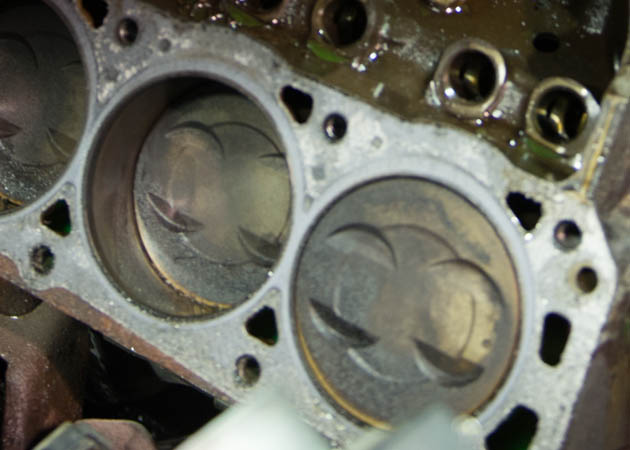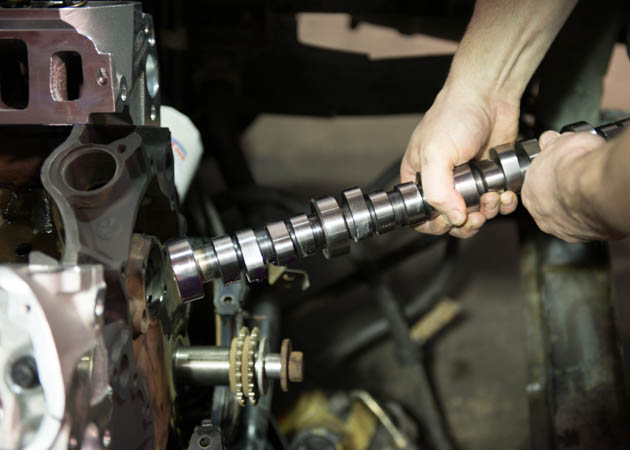The GT40 and GT40P are a cast-iron head that was found on certain production vehicles back in the 1990's. At the time, they offered a great performance boost for the price and were very easily attainable. Nowadays, while still popular, the aftermarket has essentially rendered them oboslete as the GT40 and GT40P series cannot deliver anywhere near the same level of performance. Not to say they are a bad head, they are just outdated. Read on to learn everything you need to know about these hot rod cylinder heads.
How do I identify Ford GT40 and GT40P Cylinder Heads?
Ultimate GT40/GT40P Cylinder Head Identification Chart
To verify whether you have GT40 or GT40P cylinder heads, examine the side of each cylinder head. GT40 cylinder heads have 3 vertical bars stamped on the side of the head as well as the word "GT". Ford GT40P cylinder heads have 4 vertical bars and some are stamped "GT40P". GT40's originally came equipped on the following V8 engine vehicles:
- 1993-95 Mustang Cobra: Part #F3ZE or #F4ZE
- 1996 - mid 1997 Ford Explorer and Mountaineer SUV: Part #F1ZE-AA
- Ford SVO Catalogue (1990s): Part # M-6049-L30
There is no discernable difference between the GT40 heads from any of the above vehicles. The only variation is that some may have received more milling (Cobra), depending on what Ford vehicle the cylinder head was going to be installed on.
GT40P's come only from mid-1997 and up Explorer/Mountaineer SUV models, with part #F77E-AA.
GT40 Identification: 3 bar side.jpg : 'GT' stamp.jpg
GT40P Identification: 4 bar side.jpg : 'GT40P' stamp.jpg
Differences between GT40 and GT40P?
There are some differences between the GT40 and GT40P cylinder heads. First off, GT40 heads are equipped with thermactor holes to connect to the EGR/smog equipment. GT40P heads are not. GT40P cylinder heads use an external EGR connective system (I believe in combination with the intake manifold).
However, the latter can be drilled and tapped to accomodate the EGR ports, if that is your preference. Secondly, the GT40P has a somewhat revised combustion chamber, and different spark plug placement. Because of this, not all headers clear GT40P heads. Make sure to use a known GT40P-specific header. Regular headers can be used, but then require different spark plug wires to be used, usually ones capped with 90° boots.
Furthermore, there is said to be slightly different chamber volumes. GT40 combustion chambers are slightly larger, with volumes ranging from 63-66 cc. The Explorer/Mountaineer heads (GT40P) are somewhat smaller, measured between 58-61cc chamber volume. Thus, GT40P cylinder heads may give a small bump in compression.
Finally, the last difference between the two are valves. Both have 1.84" intake valves, but the GT40 has a 1.54" exhaust valve whilst the GT40P cylinder heads have a slightly smaller one at 1.46".
GT40 vs GT40P, which are better?
Really, when you get down to it, neither head is any measurable difference better than the other. The GT40P does have a slight edge over the GT40 cylinder head because of its smaller chamber volume.
The smaller combustion chamber can net a bit more compression, but only marginally. Flow data shows them to flow within a few CFM (cubic feet per minute, more CFM is better) of each other. Conclusion: one is not downright better than the other. If you're stuck deciding between the two, go with whatever is available and at a better price.
Horsepower wise, there will not be much difference between the two. One thing you may want to consider, however, is that stock GT40P valvesprings are not capable of handling even a Foxbody stock HO cam (0.444 lift). Thus, their valvesprings will have to be changed. This is balanced by the fact that GT40 heads, for whatever reason, are more valued. GT40Ps are generally cheaper.
How much power will GT40 or GT40P heads produce?
Real world data seems to show that GT40 or GT40P cylinder heads, assuming no other mods on your Foxbody, are good to add anywhere between 20-40 HP (over stock heads). There are a lot of variables that must be addressed to give a better estimate, but a good basic estimate is 20-40 HP at the crank.
Generally speaking, GT40 or GT40P heads on a mild 5.0L (basic modifications, i.e exhaust, Cobra intake manifold, cold air intake, good air filter) will give a stout 275-325 HP at the crank (230-280 RWHP).
Where to find GT40 or GT40P cylinder heads
The great thing about GT40 and GT40P cylinder heads, despite their old iron design, is that they are pretty easy to find. Foxbody Mustang enthusiasts all over the internet are constantly buying and selling them.
A good place to look is in the classified section of a Mustang enthusiast website or forum. Another, perhaps even better, place to look is at your local junkyard. GT40 and GT40P heads were factory pieces, fitted on multiple models of Ford vehicles.
These cylinder heads can be picked up dirt cheap at a pull-a-part type yard! Craigslist too is an invaluable tool in your cylinder head search. You'd be surprised how many parts you can find listed in your local/regional Craigslist site.
Iron GT40 cylinder heads seem to be valued moreso than their GT40P counterparts, so expect to pay a little more for GT40s. I see these sell quite frequently between $250-$400 on Mustang classified sites. GT40Ps, on the other hand, can be had for as little as $200!
Even less at pick-a-parts! Junkyards occasionally even have a warranty or guarantee on parts sourced there. I once saw a complete GT40P set going for $40. car-part.com is a great place to start an online search for parts contained in scrap yards. Just keep in mind the potential added cost of a new spring package to stock GT40P heads. Their factory equipped springs are no good for even a stock Foxbody HO cam.
What springs to use for GT40P cylinder heads?
The stock springs that come installed on GT40P heads (remember, GT40P's come from factory Explorers/Mountaineers, they cannot be bought new) are awful. They may not even hold up to a 5.0L V8 Mustang's stock HO cam, rated at 0.444 lift with the stock 1.6 rockers.
When installing GT40P heads, it's imperitive you replace the springs. Of course, what spring package you pick is totally dependent on what cam and rocker combination you will be using. If you're sticking with the stock HO cam, take a look at Comp Cams 987-16 spring package. It's a great option for the stock cam and is reasonably priced at $95..
The above paragraph talks only about spring options for GT40P heads. Regular Ford GT40 iron heads aren't known for having the best valve springs either. They are better than the stock GT40P springs, but if pushing anything more than stock lift (0.444 in), it is best to replace them as well.
Keep in mind though that the cost of a spring package adds onto your overall costs of the heads. i.e: You buy a set of stock GT40Ps for $150, don't forget the added cost for springs. You may also want to get the heads checked out by a machine shop (if they haven't been already) which will add to the price as well.
What headers will fit GT40P heads?
Another slight issue with GT40P heads, in comparison to Foxbody Mustang E7 (Stock) and GT40 heads, is their sparkplug location. Because of their different placement, there can be fit issues with some headers. Here's a quick list of some headers known to fit GT40P heads with no issues at all.
These are not the only headers that will fit. In fact, almost any header can be made to fit with a little grinding and perhaps special spark plug boots. However, if you're just looking for a direct fit, the above headers are sure to work.
The Great Debate
To use GT40/GT40P heads or not to use...
The answer to this question is entirely dependent on you. Let's do a quick rundown of GT40/GT40P cylinder heads.
What are your goals for your Mustang, how much power are you looking for, how much money do you have to spend? These questions will determine whether or not you should go with GT40 style cylinder heads.
There are definitely better cylinder heads out there in the aftermarket world, but again, consider your needs (objectives, budget). Any modern designed aluminum head these days will blow GT40 and GT40P heads clean out of the water. However, you have to pay to play, and these aluminum heads don't come that cheap. Looking for a mild 300 HP build on a budget? By all means, the GT40's are for you. Craving a little more power? Say 350 HP (or the magical 300 RWHP mark), you'll need a cylinder head that moves a little more air.
- Pros
-
- Cheap, easy to find.
- Factory product = factory fit. No installation issues.
- Good for a moderate horsepower gain, 20-40 HP.
- Cons
-
- Heavy, outdated iron design
- May need upgraded springs (GT40P's).
- Only good for 20-40 HP.



